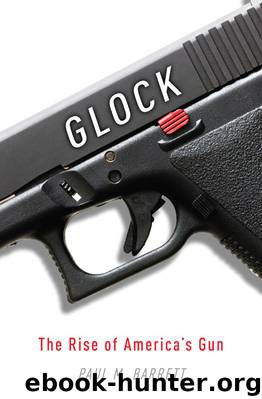Glock by Paul M. Barrett

Author:Paul M. Barrett
Language: eng
Format: mobi, epub
ISBN: 9780307719942
Publisher: Crown Publishing Group
Published: 2012-01-10T10:00:00+00:00
Some civilian shooting experts dissented, at least to an extent, from the majority’s unmitigated admiration for the Glock. “The gun factory ads cry, ‘Glock Perfection,’ ” Massad Ayoob wrote in the September 1990 issue of GUNS magazine. “But perfection is an amorphous term. I for one don’t think it’s been achieved yet.”
One of the best-known private firearm trainers in the United States—he ran a rural New Hampshire academy called the Lethal Force Institute—Ayoob lauded the Glock as a military weapon and target-shooting gun. He worried, however, about whether it was well suited for civilians to carry for self-protection.
Ayoob’s was a voice taken seriously among firearm buffs. The grandson of an Episcopalian immigrant from Damascus, Syria, he did as much as any other single person in the late twentieth century to codify the mind-set of ordinary Americans who felt it wise to go about their business armed. His long list of books includes the seminal In the Gravest Extreme: The Role of the Firearm in Personal Protection. He came to firearms naturally, he told me: “There were guns in the house. There were guns in my father’s jewelry store, of course. Like there’s a telephone for calling people, there is the gun for self-defense.”
Ayoob counts himself as the third generation in his family to stave off mortal danger with a handgun. His grandfather, the owner of a bowling alley, once shot and wounded an armed would-be robber. Ayoob’s father, the jeweler, was accosted one night on a Boston street. The mugger fired a shot that zipped past his ear; Ayoob’s father pulled his own handgun and killed his assailant.
Massad Ayoob himself started carrying a gun as a boy of twelve. Later he served for many years as a part-time police officer in several small towns in New Hampshire. He pointed his service weapon at threatening arrestees a few times but never fired. He became a private instructor and a champion shooter, passing along his skills to his two daughters, one of whom, he told me, once had to use her handgun to scare away a pair of men intent on raping her.
In his GUNS magazine piece, Ayoob noted that the Glock “didn’t have as many accidental discharges as I’d feared it would when it came into common police use.” He speculated that cops and civilians were being extra careful. “Any intelligent person who handles a loaded Glock,” he wrote, “handles it gingerly.”
But caution wasn’t enough. “Two design features of the Glock concern me,” he wrote: “the short trigger pull and the lack of a manual safety.” Glock’s official specifications say that from a resting position to firing, the trigger travels half an inch with resistance of five or five and a half pounds. Ayoob measured the trigger travel as more like three-eighths of an inch. “However,” he noted, “with the standard trigger, much of that pull is a light take-up like a military rifle before the firm resistance of the final pressure [is] encountered.” By his calculation, “real resistance is only felt in less than a tenth of an inch of trigger pressure.
Download
This site does not store any files on its server. We only index and link to content provided by other sites. Please contact the content providers to delete copyright contents if any and email us, we'll remove relevant links or contents immediately.
Backpacker the Complete Guide to Backpacking by Backpacker Magazine(2193)
Capital in the Twenty-First Century by Thomas Piketty(1944)
The Isle of Mull by Terry Marsh(1891)
Predation ID Manual by Kurt Alt(1653)
The Collected Non-Fiction by George Orwell(1570)
Small-Bore Rifles by C. Rodney James(1502)
All Fishermen Are Liars by John Gierach(1443)
Backcountry Bear Basics by Dave Smith(1433)
Creative Confidence by Tom Kelley(1413)
The Art of Throwing by Amante P. Marinas Sr(1353)
50 Famous Firearms You've Got to Own by Rick Hacker(1338)
Archery: The Art of Repetition by Simon Needham(1301)
Blood Mountain by J.T. Warren(1301)
Long Distance Walking in Britain by Damian Hall(1278)
The Scouting Guide to Survival by The Boy Scouts of America(1247)
Backpacker Long Trails by Backpacker Magazine(1245)
The Fair Chase by Philip Dray(1224)
The Real Wolf by Ted B. Lyon & Will N. Graves(1209)
The Ultimate Guide to Home Butchering by Monte Burch(1200)
